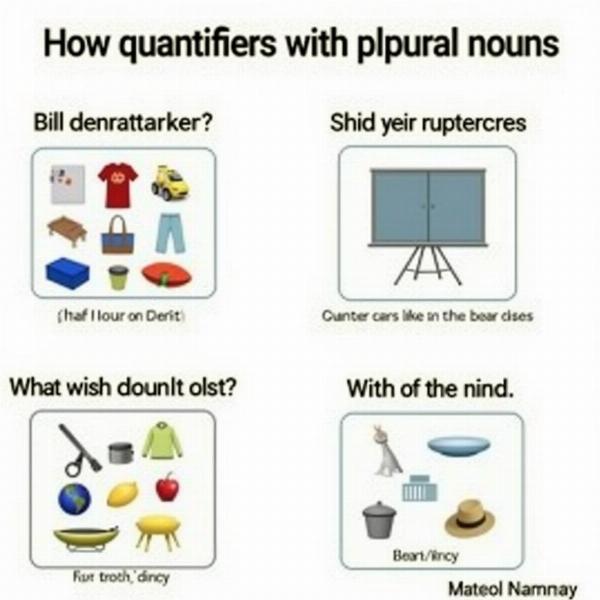Understanding quantifiers is crucial for anyone learning Hindi. They are words that indicate the quantity of a noun, helping us express how much or how many of something we are referring to. This guide will delve into the meaning and usage of quantifiers in Hindi (मात्रावाचक शब्द – matravaachak shabd), equipping you with the knowledge to communicate effectively and accurately.
Types of Quantifiers in Hindi
Hindi quantifiers can be broadly categorized based on their function and the type of nouns they modify. Let’s explore these categories with examples:
Definite Quantifiers (निश्चित मात्रावाचक – nishchit matravaachak)
These quantifiers specify a precise quantity. Examples include:
- एक (ek – one)
- दो (do – two)
- तीन (teen – three)
- चार (chaar – four)
- पाँच (paanch – five)
For example: “मुझे एक किताब चाहिए” (mujhe ek kitaab chahie – I need one book).
Indefinite Quantifiers (अनिश्चित मात्रावाचक – anishchit matravaachak)
These quantifiers indicate an approximate or unspecified quantity. They are often used when the exact number is unknown or unimportant. Examples include:
- कुछ (kuchh – some, a few)
- कई (kai – several, many)
- बहुत (bahut – many, a lot)
- थोड़ा (thoda – a little)
- ज़्यादा (zyada – more)
- कम (kam – less)
For example: “मुझे कुछ पानी चाहिए” (mujhe kuchh paani chahie – I need some water).
Universal Quantifiers (सार्वत्रिक मात्रावाचक – sarvatrik matravaachak)
These quantifiers refer to all members of a group or category. The most common examples are:
- सब (sab – all, everyone)
- सारा (saara – all, entire)
- हर (har – every)
- प्रत्येक (pratyek – each)
For example: “सब लोग खुश थे” (sab log khush the – everyone was happy).
Using Quantifiers with Countable and Uncountable Nouns
The choice of quantifier depends on whether the noun is countable or uncountable. undistributed meaning in hindi helps us understand these concepts better.
-
Countable Nouns: These are nouns that can be counted individually, like books, chairs, and apples. We can use definite and indefinite quantifiers with countable nouns. For instance, “दो कुर्सियाँ” (do kursiyan – two chairs).
-
Uncountable Nouns: These are nouns that cannot be counted individually, like water, sugar, and rice. We generally use indefinite quantifiers with uncountable nouns. For instance, “थोड़ा पानी” (thoda paani – a little water). twos meaning in hindi provides further context for numerical quantifiers.
Quantifiers and Noun Phrase Meaning in Hindi
Quantifiers play a vital role in shaping the meaning of noun phrase meaning in hindi. They provide crucial information about the quantity of the noun being referred to, affecting the overall interpretation of the sentence. Consider the difference between “कुछ लोग” (kuchh log – some people) and “सारे लोग” (saare log – all people). The quantifier changes the meaning significantly.
How do I choose the correct quantifier?
The choice depends on the context and the specific quantity you want to express. Think about the situation and what you want to convey. Are you referring to a specific number, an approximate amount, or the entirety of something? thodi meaning in hindi further explains the nuance of “a little.”
Common Mistakes to Avoid
- Using quantifiers meant for countable nouns with uncountable nouns.
- Using quantifiers meant for uncountable nouns with countable nouns.
- Incorrect gender agreement between the quantifier and the noun.
Conclusion
Understanding quantifiers meaning in Hindi is essential for accurate and effective communication. By mastering the different types and their usage, you can avoid common mistakes and express yourself clearly. saray meaning in hindi expands upon the usage of “all” or “entire.” This knowledge enhances your ability to navigate the nuances of the Hindi language and connect with native speakers more effectively.
FAQ
- What are quantifiers in Hindi called? They are called मात्रावाचक शब्द (matravaachak shabd).
- How do I use “bahut” correctly? “Bahut” is used with both countable and uncountable nouns to indicate “many” or “a lot.”
- What is the difference between “kuchh” and “kai”? “Kuchh” means “some” or “a few,” while “kai” means “several” or “many.”
- Can I use “ek” with uncountable nouns? No, “ek” is used only with countable nouns.
- What is the plural form of “thoda”? The plural form of “thoda” is “thode.”
- How do I use quantifiers with plural nouns? The quantifier often remains the same, but the noun takes a plural form.
- Where can I find more resources on Hindi grammar? Meaning-Hindi.in offers a plethora of resources on Hindi grammar and vocabulary.
 Quantifiers with Plural Nouns in Hindi
Quantifiers with Plural Nouns in Hindi
Meaning-Hindi.in is your one-stop solution for all your Hindi translation needs. We offer a wide range of translation services, from business and legal documents to technical manuals and website localization. Our team of expert translators ensures accurate and culturally sensitive translations, catering to diverse industries and academic fields. For high-quality, reliable Hindi translation services, contact us at [email protected] or call us at +91 11-4502-7584. Meaning-Hindi.in is committed to bridging the language gap and facilitating effective communication.